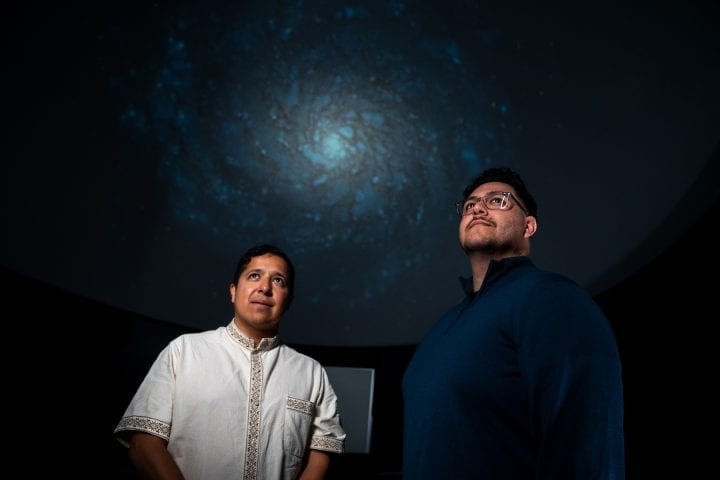Reviewed by Lexie CornerApr 30 2024
A group of researchers from the University of California, Irvine Department of Physics and Astronomy used computer simulations to show that features observed in real galaxies are difficult to explain without dark matter. This supports the existence of dark matter as the leading model for describing the universe. The group published their findings in the Monthly Notices of the Royal Astronomical Society.
 Francisco Mercado (right), a recent Ph.D. graduate from the UC Irvine Department of Physics & Astronomy who is now a postdoctoral scholar at Pomona College, and Jorge Moreno (left), associate professor of physics and astronomy at Pomona College, ran computer simulations to support the idea that dark matter exists and helps to explain how the universe works. Their work is the subject of a paper published recently in Monthly Notices of the Royal Astronomy Society. Image Credit: Pomona College.
Francisco Mercado (right), a recent Ph.D. graduate from the UC Irvine Department of Physics & Astronomy who is now a postdoctoral scholar at Pomona College, and Jorge Moreno (left), associate professor of physics and astronomy at Pomona College, ran computer simulations to support the idea that dark matter exists and helps to explain how the universe works. Their work is the subject of a paper published recently in Monthly Notices of the Royal Astronomy Society. Image Credit: Pomona College.
The study tackles a central question in astrophysics: can physicists explain how things work using only the matter that can be observed directly, or do they also need to include invisible dark matter? Many physicists today believe that the motions of stars and galaxies can only be explained by the existence of something akin to dark matter.
Our paper shows how we can use real, observed relationships as a basis to test two different models to describe the universe; we put forth a powerful test to discriminate between the two models.
Francisco Mercado, Lead Author, Department of Physics and Astronomy, University of California, Irvine
Mercado recently graduated with a Ph.D. from the UC Irvine Department of Physics and Astronomy and is now a Postdoctoral Scholar at Pomona College.
The experiment comprised computer simulations involving both conventional and dark matter to elucidate the peculiar characteristics observed in actual galaxies.
The features in galaxies the team found are expected to appear in a universe with dark matter but would be difficult to explain in a universe without it; we show that such features appear in observations of many real galaxies. If we take these data at face value, this reaffirms the position of the dark matter model as the one that best describes the universe we live in.
Francisco Mercado, Lead Author, Department of Physics and Astronomy, University of California, Irvine
Mercado observed certain characteristics that characterize the movements of stars and gas in galaxies, which appear to be exclusive to a universe containing dark matter.
Observed galaxies seem to obey a tight relationship between the matter we see and the inferred dark matter we detect, so much so that some have suggested that what we call dark matter is evidence that our theory of gravity is wrong, what we showed is that not only does dark matter predict the relationship, but for many galaxies, it can explain what we see more naturally than modified gravity. I come away even more convinced that dark matter is the right model.
James Bullock, Professor and Co-Author, Department of Physics, University of California, Irvine
The characteristics also show up in observations by universe-free dark matter proponents.
Jorge Moreno, Co-Author and Associate Professor of Physics and Astronomy at Pomona College, said, “The observations we examined–the very observations where we found these features–were conducted by adherents of dark matter-free theories, despite their obvious presence, little-to-no analysis was performed on these features by that community. It took folks like us, scientists working with both regular and dark matter, to start the conversation.”
As a result of the study, Moreno anticipates disagreement within his field of study. Still, there might be room for compromise because the team also discovered that these features only show up in their simulations when the universe contains both dark matter and normal matter.
Moreno said, “As stars are born and die, they explode into supernovae, which can shape the centers of galaxies, naturally explaining the existence of these features; simply put, the features we examined in observations require both the existence of dark matter and the incorporation of normal-matter physics.”
Mercado clarified that the next step is to determine whether the dark matter model of the universe holds throughout a dark matter universe since it currently seems to be the most likely one.
Moreno said, “It would be interesting to see if we could use this same relationship to even distinguish between different dark matter models; understanding how this relationship changes under distinct dark matter models could help us constrain the properties of dark matter itself.”
National Science Foundation MSP-Ascend Award to Mercado. Mercado and Bullock were supported by NSF grant and NASA. Moreno received funding from the Hirsch Foundation.
Collaborators include Michael Boylan-Kolchin (The University of Texas at Austin), Philip F. Hopkins (California Institute of Technology), Andrew Wetzel (University of California, Davis), and Claude-André Faucher-Giguère (Northwestern University), and Jenna Samuel (The University of Texas at Austin).
Journal Reference:
Mercado, F. J., et al. (2024) Hooks & Bends in the radial acceleration relation: discriminatory tests for dark matter and MOND. Monthly Notices of the Royal Astronomical Society. doi.org/10.1093/mnras/stae819